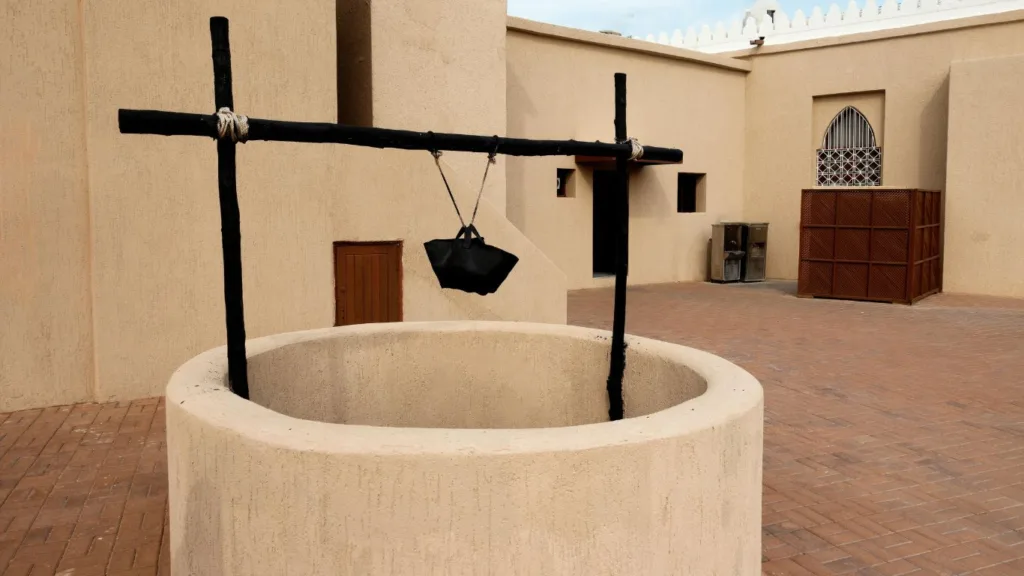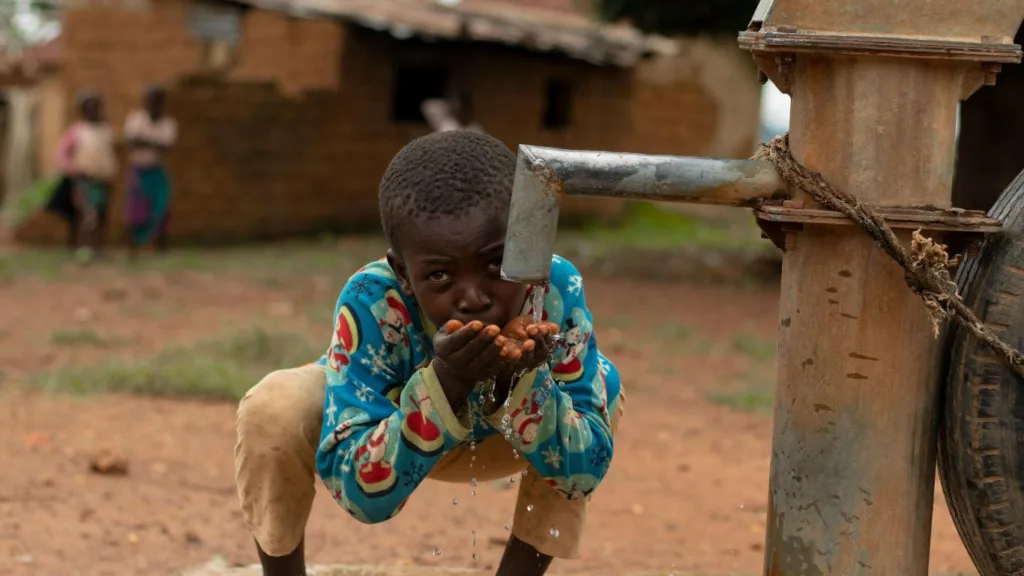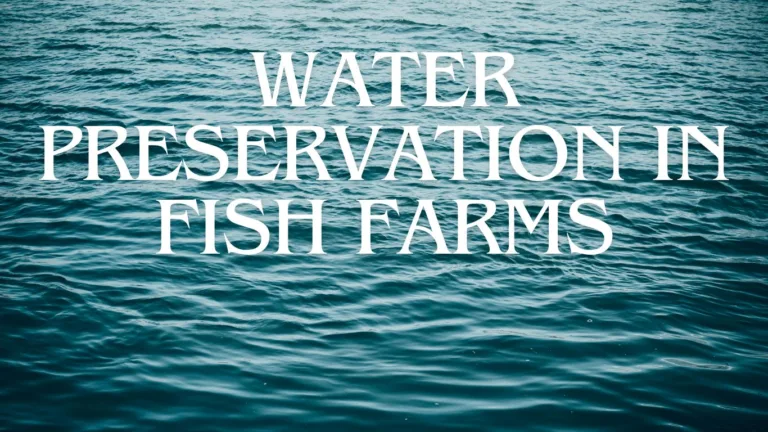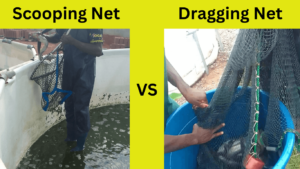Water preservation in fish farms is as crucial as the fish itself. For fish, water is life. Fish cannot survive without water, That is why every fish farmer should know how to preserve and make the judiciary use of the water available on the farm.
Before you set up your fish farm, you must consider the type of water your preferred fish species like. Consider the source of the water, and consider the physician or chemical characteristics of the water.
Also, look at the factors that cause water loss or wastage in your fish farm and try to avoid them.
Types of water use in fish farm
Each type of water has its challenges and requirements depending on the species of fish being raised and the environmental conditions. There are three different types of water used in fish farming. These three types are;
1. Freshwater
Most fish farming occurs in freshwater environments such as ponds, lakes, rivers, and freshwater tanks. Freshwater is the type of water with no or less salt in it. The salt concentration is as less as 0.5 parts per thousand (ppt).
As some fish species prefer saltwater, most fish species prefer freshwater.
2. Saltwater
This is the type of water in aquaculture with more salt concentration. Typically around 35ppt or higher.
3. Brackish water
Brackish water is the type that has a mixture of both freshwater and saltwater in it. Some fish species, like tilapia and certain types of shrimp, can be farmed in brackish water.
Sources of water in fish farm
The sources of water in fish farming can vary depending on the operation, location, and available resources. Some of them include;
1. Natural water bodies
Ponds
Natural or man-made ponds are commonly used for fish farming, especially in freshwater aquaculture. Ponds provide a controlled environment for fish rearing and can be stocked with various species of fish.
Lakes and reservoirs
Fish farming in lakes or reservoirs involves utilizing natural water bodies for aquaculture purposes. Lakes or reservoirs are bodies of fresh water usually surrounded by land.
This method is suitable for large-scale operations and requires proper management to maintain water quality and ecosystem health. These can be man-made or natural
Rivers and streams
Some fish farms utilize flowing water from rivers or streams. Rivers or streams are flowing water bodies in a channel to sea or another river.
This method requires careful consideration of water flow rates, temperature, and environmental impact to ensure sustainable production.

river
2 Groundwater
Wells or Borehole
Groundwater from wells or boreholes can be used for fish farming, especially in areas where surface water sources are limited or unreliable. Wells or boreholes are the type of water source that come from deep underground. This can be dug by manual or machine. The water is usually extracted through pipes, pumps, and other equipment in terms of boreholes. For wells, sometimes it can be fetched through ropes tied with containers and can also be fetched through pumps and pipes.
Wells or boreholes provide a consistent supply of water, but quality and quantity may vary depending on factors such as geology and aquifer recharge rates. These sources sometime may also be freshwater or saltwater depending on the geography.
The quantity of the water supply by wells or boreholes is determined by the water table of the land. If the water table is high, the water quantity is also going to be high. If the water table is low, the water quantity will also be low as well.
Underground water is the most preferred water for fish farming

well

borehole
3. Municipal or Potable Water Supply
Tap water
Fish farms located in urban or peri-urban areas may rely on municipal or potable water supplies. This source is convenient and typically of high quality, but water treatment may be necessary to remove chlorine, chloramines, or other contaminants harmful to fish.
Unfortunately, during the water treatment process, harmful chemicals for fish may be introduced into the water. For instance, high chlorine is harmful to fish.
I know someone who stocked 500 catfish in a pond with tap water and lost all the fish. He again stocked another 500 but was able to get only 10 fish from them.
If tap water is your only source for your fish farm, then you need to always treat the water. You can do that by leaving the water in an open reservoir or the fish pond for about 3 days before introducing the fish into it.
You can also add fish plants into the fish pond to neutralize the chemicals in the water before introducing the fish into the pond.
4. Rainwater harvesting
Rainwater collection/harvesting
Some fish farms introduce rainwater harvesting systems to supplement water supply or reduce reliance on other sources.
Rainwater can be collected from rooftops or catchment areas and stored in tanks or reservoirs for use in fish farming activities.
Recommendation of The Best Water Source For Fish Farm
Groundwater is the best source of water used in fish farms. The groundwater originates from springs, wells, and or boreholes. It passes the criteria for a good quality water source for fish farms because it is often free of pollutants. It also has a high hardness level is good for fish if not in excess. If it’s in excess, it can be removed by agitation. Source
Factors to Consider When Selecting a Water Source for Your Fish Farm
When selecting a water source for your fish farm, several factors need to be considered to ensure optimal conditions for your fish’s health, growth, and overall farm sustainability. Here are some of the factors to consider:
1. Water quality
Physical and Chemical parameters
Assess factors such as temperature, pH, dissolved oxygen levels, Carbon dioxide, Nitrogen, ammonia, and conductivity. These parameters directly affect fish health, growth, and behavior. Before choosing any source of water for your fish, you need to do the necessary tests of the above parameters. The results should guide you.
- Oxygen Levels: low dissolved oxygen in your fish pond can cause fish mortality. The ideal oxygen level in the fish pond must be at least 5 ppm. You can add aeration to boost the oxygen level of your fish pond. Oxygen levels more than 55 ppm can stress the fish and less than 2 ppm can also lead to fish mortality.
- pH: the average pH level of your fish water source should be 6.5 – 9.0. Above this figure is dangerous for your fish farm.
- Carbon Dioxide: carbon dioxide is important for your fish farm however, excess of it is also dangerous. The level should be 5 – 15 ppm but is dangerous if is 20 ppm or more.
- Nitrogen: Fish water above 110% is considered higher. The introduction of aeration to subsidies nitrogen will be better
- Ammonia: The excretion of fish in the pond introduces ammonia to the pond and excess of it causes mortality. An ammonia level of 0.02 ppm is safe but above that is dangerous. You can introduce aquaponics to always convert the ammonia to nitrate.
Test for pollutants, heavy metals, pesticides, and other contaminants that may be present in the water in your fish farm. Ensure that water quality meets the requirements of the target fish species.
Biological indicators
Evaluate the presence of algae, plankton, bacteria, and other microorganisms that may influence water quality and fish health in your farm.
2. Water quantity and availability
- Determine the volume of water required for fish farming operations based on your stocking density, species selection, and production goals.
- Consider seasonal variations in water availability, especially in areas exposed to drought or water scarcity.
3. Water Source Location and Proximity
- Evaluate the proximity of potential water sources to your fish farm site. Opt for sources that minimize transportation costs, energy consumption, and logistical challenges.
- Consider accessibility and ease of infrastructure development for water intake, distribution, and waste management systems.
- Consider an alternative water source in case your main source fails. Always have a plan B
4. Water Source Stability and Resilience
- Assess the resilience of the water source to environmental fluctuations, such as seasonal variations in flow rates, water level changes, and extreme weather events.
- Consider the potential impacts of climate change, including alterations in precipitation patterns, water availability, and temperature regimes.
5. Regulatory and Legal Considerations
- Understand and comply with local and international regulations governing water use, abstraction, discharge, and environmental protection.
- Obtain necessary permits, licenses, or approvals for water abstraction and fish farming activities, including water rights and pollution control measures.
6. Cost-Effectiveness and Sustainability
- Evaluate the financial implications of accessing and utilizing your chosen water source, including infrastructure investment, operational expenses, and maintenance costs.
- Consider the long-term sustainability of water use practices, aiming to minimize environmental impact, resource depletion, and ecological disturbance.
7. Risk Assessment and Mitigation
- Identify potential risks associated with your chosen water source, such as contamination, pollution, disease transmission, and invasive species introduction.
- Develop appropriate risk management strategies and contingency plans to mitigate adverse impacts and ensure farm resilience.
Causes of Water Loss or Wastage in Fish Farm
Water loss or wastage in fish farming can occur due to various factors, ranging from inefficiencies in water management practices to environmental factors beyond the farmer’s control.
1. Evaporation
- Evaporation is a natural process whereby water vaporizes into the atmosphere, leading to loss from fish ponds, tanks, or reservoirs.
- Factors such as high temperatures, low humidity, and wind speed can accelerate evaporation rates, resulting in significant water loss over time.
2. Leakage and Seepage
- Leakage occurs when water escapes from ponds, tanks, or containment structures due to cracks, holes, or inadequate lining materials.
- Seepage refers to the slow movement of water through porous soil or substrate, leading to loss from the aquaculture system.
- Poorly constructed or maintained infrastructure, including earthen ponds without proper sealing or liners, can contribute to leakage and seepage losses.
3. Overflow and Spillage
- Overflow occurs when water in the fish farm exceeds the capacity of containment structures, such as ponds or tanks, leading to spillage and loss.
- Inadequate water level management, improper sizing of structures, or sudden influxes of water from rainfall or inflow sources can cause overflow events.
4. Splash and Spray Loss
- Splash and spray loss occur when water splashes out of ponds or tanks due to wind action, turbulence, or fish activity.
- High stocking densities, aggressive fish behavior, or inadequate water depth can cause splash and spray losses, especially in open systems.
5. Drainage and Flushing
- Drainage and flushing practices are employed to remove excess nutrients, sediment, and waste products from aquaculture systems.
- While necessary for maintaining water quality and preventing the buildup of pollutants, excessive drainage or flushing can result in unnecessary water loss on your farm. Most especially if not managed properly.
6. Spillage During Handling and Transport
- Water may be lost during handling and transport activities, such as during fish harvesting, grading, sorting or transfer between tanks or ponds.
- Improper handling techniques, equipment malfunctions, or human error can lead to spillage and waste of water resources.
7. Predation and Wildlife Interactions
Predatory birds, mammals, and other wildlife may prey on fish or disturb aquaculture systems, causing water loss, and fish mortality in your fish farm.
8. Uncontrolled Water Usage
Inefficient water management practices as a farmer, such as excessive water exchanges, and overfilling of ponds or tanks. And also unnecessary water treatments can contribute to water wastage in your fish farm.
How to Preserve Water in Fish Farm
Preventing, minimizing, and preserving water in fish farming is essential for sustainable aquaculture practices and efficient resource utilization.
1. Implement Water-Saving Technologies
- Utilize Recirculating Aquaculture Systems (RAS) to continuously filter, treat, and recycle water within closed-loop systems. RAS technology minimizes water exchange and reduces overall water consumption on your farm.
- Install water-efficient equipment such as low-flow pumps, aerators, and filters to optimize water use and minimize wastage.
- Incorporate water-saving irrigation methods in your farm. These include; drip or trickle irrigation, supplemental feeding, or water exchange in aquaculture ponds.
2. Optimize Pond Design and Management
- Construct your fish ponds with proper sizing, depth, and slope to minimize surface area and evaporation losses.
- Line ponds with impermeable materials, such as clay liners or geomembranes, to prevent leakage and seepage losses.
- Implement water-saving pond management practices on your farm. These include strategic water level control, sediment removal, and vegetation management, to enhance water retention and quality.
3. Promote Water Conservation Practices
- Implement water reuse and recycling strategies to minimize the need for freshwater replenishment. Reuse treated wastewater or effluent from other agricultural activities for pond replenishment or irrigation.
- Practice integrated aquaculture-agriculture systems, such as aquaponics or integrated rice-fish farming, to maximize water use efficiency and nutrient recycling in your farm.
4. Adopt Efficient Feeding and Stocking Practices
- Optimize feeding strategies to minimize feed wastage and nutrient excretion, which can contribute to water pollution and increased water exchange requirements.
- Monitor your stocking densities and avoid overstocking to prevent overcrowding and excessive nutrient loading in aquaculture systems.
5. Manage Water Quality and Treatment
- Implement water quality monitoring programs to assess parameters such as dissolved oxygen, pH, ammonia, and nitrate levels.
- Maintain optimal water quality conditions to reduce stress on fish and minimize water exchange requirements.
- Employ natural or biological water treatment methods in your fish farm. Such as constructed wetlands, biofiltration, or phytoremediation, to remove pollutants and enhance water quality without excessive water exchange.
6. Control Pests, Predators, and Wildlife Interactions
- Install physical barriers, such as netting or fencing, to deter predatory birds, mammals, and other wildlife from accessing your aquaculture facilities and causing fish mortality or water disturbance.
- Implement Integrated Pest Management (IPM) strategies to control pests and pathogens without relying on excessive water treatments or chemical interventions.
7. Educate and Train Farmers on Water-Saving Practices
- Provide training and extension services to fish farmers on water conservation techniques, efficient water management, and sustainable aquaculture practices. This will create their awareness of the subject matter.
- Raise awareness about the importance of water preservation and encourage the adoption of best management practices to minimize water use and environmental impact.
Conclusion
As a fish farmer, if you can implement these measures, you will not only minimize your water use but also will save a lot of money on water. Water is kind in fish farming hence it must be treated as such. Remember to always have a plan B. In other words, have an alternative source of water apart from your main source. This will only serve as a cushion in case the main source fails you.
When we are talking about water in fish farming, is not only about availability, but also the quality. Sometimes the water may be available but not good for the fish. Always consider all that.




awesome
This website definitely has all the information I wanted about this subject and didn’t know who to ask.
Spot on with this write-up, I seriously believe that this amazing site needs far more attention. I’ll probably be returning to read through more, thanks for the info.
I want to to thank you for this good read!! I certainly loved every bit of it. I have got you bookmarked to look at new things you post…
Good article. I certainly appreciate this site. Keep it up!
Nagano Lean Body Tonic: An IntroductionNagano Lean Body Tonic is a dietary supplement designed to help lose unhealthy weight
Very interesting details you have observed, regards for posting.!
hello there and thank you for your information – I’ve certainly picked up something new from right here.
I did however expertise a few technical points using this website, as I experienced to reload the website a lot of times previous to I could get it to load
correctly. I had been wondering if your web hosting is OK?
Not that I am complaining, but sluggish loading instances times will often affect
your placement in google and could damage your quality score if advertising and
marketing with Adwords. Well I’m adding
this RSS to my email and could look out for much more of your respective intriguing content.
Ensure that you update this again soon..
Escape room
Thank you for your sharing. I am worried that I lack creative ideas. It is your article that makes me full of hope. Thank you. But, I have a question, can you help me?
самая большая звезда в солнечной системе, самая большая
звезда в галактике сцеживать грудь во сне сонник попугай
красный встретимся ли мы с умершими родственниками солнце единственная звезда солнечной системы, сообщение о
солнце 4 класс
[…] Water Quality: Maintaining good water quality is crucial during egg incubation. Oxygen levels must be high, and water temperature should be […]
Greetings! This is my first visit to your blog! We are a group of volunteers and starting a new project in a community in the same
niche. Your blog provided us useful information to work on. You have done a marvellous job!
Great to know this. Thanks. best of luck in your project
I don’t know whether it’s just me or if perhaps everybody else encountering issues with your blog.
It appears as if some of the written text in your posts
are running off the screen. Can somebody else please comment and
let me know if this is happening to them too?
This may be a problem with my web browser because I’ve
had this happen before. Thank you
Thank you for the information